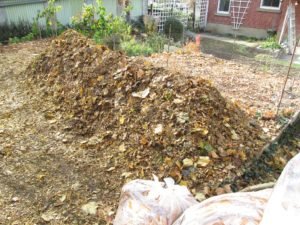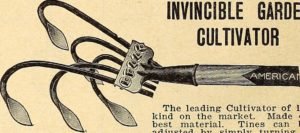We use three methods of production in our urban garden: raised beds, containers and in-ground. Each method has pros and cons.
Using raised beds for vegetables works best for us, but we started out in the traditional way of planting in-ground. The results from the first small vegetable plot were disappointing at first.
The clay soil seemed to have an unlimited appetite for soil amendments. We add organic matter to this plot each year. Though we get good harvests from this garden, it took a lot more work than we originally expected to develop the soil structure.
Growing In-ground
A lot of effort went into testing and amending our garden plots and flower beds before planting, but it paid off.
The importance of soil preparation can’t be overstated. And it’s critical before you plant perennials or anything that will be permanent in the landscape.
Though vegetable plots and areas where annuals will be grown can be amended each growing season, take care to prepare the soil properly in these areas, as well.
Testing and amending the soil before planting is the not-so-secret secret to large yields.

The Pros of in-ground gardening:
- It’s the most efficient and cost effective method for large gardens
- You avoid the need to construct raised beds
- It may cost less to amend the soil than to build and fill raised beds with good quality soil
- Planting in-ground may be the only option in some areas
- Properly amended soil will retain moisture better than raised beds or container gardens; less risk of the soil drying out too much
The Cons of in-ground gardening:
- Some types of soil, such as clay, are costly and difficult to amend
- Prone to weeds
- The soil tends to get compacted over the season
- Looks untidy to some people who may prefer the look of raised beds or containers
If we had known beforehand how hard it would be to amend the clay soil, we would have used raised beds instead. Even after amending our in-ground vegetable plot each year, the raised beds still outperform.
Growing in Raised Beds
Raised beds are our preferred method for vegetable and herb gardening. They are less work overall than in-ground gardening, and we get better yields.
You can make raised beds from many different materials. Wood, concrete, brick and stone are commonly used.
Also, a wide variety of beautiful premade raised beds are available that add a nicely finished look to your garden. If you are not handy with tools, this is a good option.
We used wood for our first raised bed. After that we switched to solid 8 x 16 x 4 inch concrete blocks bonded together with PL construction adhesive.

The blocks are fairly expensive, but the beds are virtually indestructible and will last. The cons are that they can’t be moved once built, and they are not very decorative. Luckily, there is another solution using concrete that eliminates both these problems.
Recently, we came across this fascinating video by Man About Tools showing how to construct forms for casting concrete raised beds.
These beds can be assembled in different configurations and disassembled with ease. They look good, too. But you need good carpentry skills and the tools to do this yourself or you must hire someone who does.
The nice thing about this method of making raised beds is that the forms can be used repeatedly to make any number of raised beds.
The Pros of using raised beds:
- You don’t have to amend the soil before planting the first season
- You start with properly prepared, pH balanced soil
- The surface area is higher up, so there is less strain on your back when tending the garden
- They look good in the landscape
- The beds drain well, but moisture levels need to be monitored
- Easy to edge and mow around
- They can be covered with netting if necessary
- Easy to erect a trellis in
The Cons of using raised beds:
- Can be costly and time consuming to construct depending on the material used; pre-made beds are not cheap but are an option
- You must fill the beds with good quality garden soil which is expensive
- Require topping up as organic matter in the soil is used up
- Moisture levels need to be monitored
The production from our raised beds is nothing short of phenomenal. Once the beds have been set up they are less work than planting in-ground. And you get at least as large a crop if not larger.
Growing In Containers
Even though there is enough space for both raised beds and in-ground gardens, we use containers on the patio and alongside the house, for hanging baskets and for window boxes.

Container gardening is fun and a viable method of gardening. It’s the only option for many people.
The Pros of growing in containers:
- Easily moved around and positioned
- Possible to grow in areas where no other method can be used
- Good for people with limited space; balconies, patios etc.
- Invasive plants can be contained
- The containers themselves often add a decorative element; they can enhance the overall beauty and style of a garden
- Plants can be isolated and protected
- Weeding is practically eliminated
The Cons of growing in containers:
- Must use top quality soil that retains moisture well
- Tend to dry out relatively quickly
- Easy to over-water
- Moisture levels can be uneven around the pot
- Often when a pot gets too dry it is difficult to moisten the soil again; water runs straight through and drains away
- More susceptible to hot and cold temperatures; glazed plant pots get extremely hot in the direct sunshine; terracotta pots are a better choice in these areas
- Plants have limited space to grow in; their roots are confined which may restrict growth and production
- Some plants don’t do well in containers
We use containers for flowers, but they can also be used to grow vegetables.
Friends of ours grow tomatoes in containers on their balcony. They grow enough tomatoes during the season that they don’t buy any from the grocery store.
A Bit More About Our Urban Garden
The garden has matured since 2003 when we took a desolate space and made it productive.
Three hazelnut trees planted in 2004 are in full production, and the raspberries can be relied on for a bumper crop each year.
The issue is that it takes a fair amount of time to harvest the nuts and berries. When they are ready to pick you must move quickly before the birds, squirrels and Shih Tzus take more than their share.
Often when you see something stirring the raspberry bushes on a calm, windless day it’s a sign there’s a Shih Tzu in there helping with the harvest.
If you look closely at the following picture you can just barely discern the outline of a Shih Tzu in our raspberry patch!

Most of what we preserved last year we grew in our back garden which is in the urban core of the city. The yield was quite astonishing given the limited space available.
We managed to grow enough cucumbers, dill and garlic to make sixty quarts of dill pickles! I say “we” but the fact is Theresa did most of the work.
When you also consider the 100 pints of tomatoes that “we” grew and canned you get some idea of just how hard she works. It’s almost enough to cause a sense of guilt.
In fact, watching her work can be so exhausting I often feel like having a nap. Anyway, it’s best to keep out of the way as much as possible. You know: have a cup of tea or something.
But seriously, gardening is a fun, healthy and productive activity that makes you feel well.
And the truth is we both love to get out and work in the garden. It doesn’t seem like work if you love doing something.
Though, I wonder sometimes how “we” find the time and energy to do it all.



